Bilayer Local Search Enhanced Particle Swarm Optimization for the Capacitated Vehicle Routing Problem
Abstract
:1. Introduction
2. Mathematical Formulation
3. Proposed Methodology
3.1. PSO for CVRP
3.2. Decoding the Customer Vector
| Algorithm 1. Distance-based decoding method. |
| Inputs x: customer vector m: number of vehicles given in the problem statement Outputs routesMade: a Boolean value Indicating whether routes could successfully been made route: The routes made Procedure 1. for r = 1 to m do 2. route(r) = x(r); // put the first m nodes in x as the starting nodes of the m routes 3. end for 4. i = m; 5. while i <= |x| do 6. i = i + 1; // index of the next node in x to insert in any route 7. sortedRoutes = indices of routes sorted in non-increasing order based on distances of their last nodes to x(i) 8. assigned = 0; 9. for j = 1 to |sortedRoutes| do 10. r = sortedRoutes(j); 11. if addition of x(i) to the end of route(r) satisfies Equations (5) and (6) then 12. add x(i) to the end of route(r); 13. assigned = 1; 14. go to 18; 15. end if 16. end for 17. if assigned == 0 // x(i) was not assigned to any route in the loop from line 10 to 17 then 18. maxRouteSize = maximum number of nodes assigned to a route 19. for k = maxRouteSize down to 1 do 20. sortedRoutes = indices of routes sorted in non-increasing order based on the increases of the distances if the kth nodes of the routes are replaced by x(i) 21. for j = 1 to |sortedRoutes| do 22. r = sortedRoutes(j); 23. if replacing kth node of route(r) by x(i) satisfies Equations (5) and (6) then 24. add kth node to the end of x; // to be assigned again 25. replace kth node of route(r) by x(i); 26. assigned = 1; 27. go to 33; 28. end if 29. end for 30. end for 31. end if 32. if assigned == 0 then 33. routesMade = 0; 34 return; 35. end if 36. end while 37. routesMade = 1; 38. return; |
3.3. Proposed Bilayer Local Search
3.3.1. The First Layer Local Search
3.3.2. The Second Layer Local Search
| Algorithm 2. Refining the pool of solutions |
| Input P: a pool of global best solutions Output P’: The refined pool of solutions Procedure 1. for each solution s in P do 2. if s is the best solution in P then 3. add s to P’ 4. else if s was updated in the previous iteration then 5. add s to P’ 6. end if 7. end for |
4. Computational Result Analysis
4.1. Setting the Parameters
4.2. Result Analysis
4.3. Comparative Performance of PSO-Based Approaches
5. Conclusions
Acknowledgments
Author Contributions
Conflicts of Interest
References
- Ćirović, G.; Pamučar, D.; Božanić, D. Green logistic vehicle routing problem: Routing light delivery vehicles in urban areas using a neuro-fuzzy model. Expert Syst. Appl. 2014, 41, 4245–4258. [Google Scholar] [CrossRef]
- Dell’Amico, M.; Righini, G.; Salani, M. A branch-and-price approach to the vehicle routing problem with simultaneous distribution and collection. Transp. Sci. 2006, 40, 235–247. [Google Scholar] [CrossRef]
- Erdoğan, S.; Miller-Hooks, E. A green vehicle routing problem. Transp. Res. Part E 2012, 48, 100–114. [Google Scholar] [CrossRef]
- Lei, H.; Laporte, G.; Guo, B. The capacitated vehicle routing problem with stochastic demands and time windows. Comput. Oper. Res. 2011, 38, 1775–1783. [Google Scholar] [CrossRef]
- Xiao, Y.; Zhao, Q.; Kaku, I.; Xu, Y. Development of a fuel consumption optimization model for the capacitated vehicle routing problem. Comput. Oper. Res. 2012, 39, 1419–1431. [Google Scholar] [CrossRef]
- Dantzig, G.B.; Ramser, J.H. The truck dispatching problem. Manag. Sci. 1959, 6, 80–91. [Google Scholar] [CrossRef]
- Lenstra, J.K.; Kan, A.H.G. Complexity of vehicle routing and scheduling problems. Networks 1981, 11, 221–227. [Google Scholar] [CrossRef]
- Christofides, N.; Mingozzi, A.; Toth, P. Exact algorithms for the vehicle routing problem, based on spanning tree and shortest path relaxations. Math. Program. 1981, 20, 255–282. [Google Scholar] [CrossRef]
- Clarke, G.; Wright, J.W. Scheduling of vehicles from a central depot to a number of delivery points. Oper. Res. 1964, 12, 568–581. [Google Scholar] [CrossRef]
- Gaskell, T.J. Bases for vehicle fleet scheduling. J. Oper. Res. Soc. 1967, 18, 281–295. [Google Scholar] [CrossRef]
- Mole, R.H.; Jameson, S.R. A sequential route-building algorithm employing a generalised savings criterion. J. Oper. Res. Soc. 1976, 27, 503–511. [Google Scholar] [CrossRef]
- Paessens, H. The savings algorithm for the vehicle routing problem. Eur. J. Oper. Res. 1988, 34, 336–344. [Google Scholar] [CrossRef]
- Fisher, M.L.; Jaikumar, R. A generalized assignment heuristic for vehicle routing. Networks 1981, 11, 109–124. [Google Scholar] [CrossRef]
- Gillett, B.E.; Miller, L.R. A heuristic algorithm for the vehicle-dispatch problem. Oper. Res. 1974, 22, 340–349. [Google Scholar] [CrossRef]
- Beasley, J.E. Route first—Cluster second methods for vehicle routing. Omega 1983, 11, 403–408. [Google Scholar] [CrossRef]
- Goldberg, D.E. Genetic Algorithms in Search, Optimization, and Machine Learning. Mach. Learn. 1988, 3, 95–99. [Google Scholar] [CrossRef]
- Berger, J.; Barkaoui, M. A hybrid genetic algorithm for the capacitated vehicle routing problem. In Proceedings of the Conference on Genetic and Evolutionary Computation, Chicago, IL, USA, 12–16 July 2003; Springer: Berlin/Heidelberg, Germany, 2003; pp. 646–656. [Google Scholar]
- Glover, F. Tabu search—Part I. ORSA J. Comput. 1989, 1, 190–206. [Google Scholar] [CrossRef]
- Glover, F. Tabu search—Part II. ORSA J. Comput. 1990, 2, 4–32. [Google Scholar] [CrossRef]
- Toth, P.; Vigo, D. The granular tabu search and its application to the vehicle-routing problem. Informs J. Comput. 2003, 15, 333–346. [Google Scholar] [CrossRef]
- Kirkpatrick, S.C.; Gelatt, D.; Vecchi, M.P. Optimization by simulated annealing. Science 1983, 220, 671–680. [Google Scholar] [CrossRef] [PubMed]
- Lin, S.W.; Lee, Z.J.; Ying, K.C.; Lee, C.Y. Applying hybrid meta-heuristics for capacitated vehicle routing problem. Expert Syst. Appl. 2009, 36, 1505–1512. [Google Scholar] [CrossRef]
- Baker, B.M.; Ayechew, M.A. A genetic algorithm for the vehicle routing problem. Comput. Oper. Res. 2003, 30, 787–800. [Google Scholar] [CrossRef]
- Carwalo, T.; Thankappan, J.; Patil, V. Capacitated vehicle routing problem. In Proceedings of the 2nd International IEEE Conference on Communication Systems, Computing and IT Applications (CSCITA), Mumbai, India, 7–8 April 2017; pp. 17–21. [Google Scholar]
- Hertz, A.; Laporte, G.; Mittaz, M. A tabu search heuristic for the capacitated arc routing problem. Oper. Res. 2000, 48, 129–135. [Google Scholar] [CrossRef]
- Teymourian, E.; Kayvanfar, V.; Komaki, G.M.; Zandieh, M. Enhanced intelligent water drops and cuckoo search algorithms for solving the capacitated vehicle routing problem. Inf. Sci. 2016, 334, 354–378. [Google Scholar] [CrossRef]
- Yu, B.; Yang, Z.Z.; Yao, B. An improved ant colony optimization for vehicle routing problem. Eur. J. Oper. Res. 2009, 196, 171–176. [Google Scholar] [CrossRef]
- Blum, C.; Li, X. Swarm Intelligence. In Swarm Intelligence in Optimization; Blum, C., Merkle, D., Eds.; Springer: Berlin/Heidelberg, Germany, 2008; pp. 43–85. [Google Scholar]
- Hu, X.; Eberhart, R.C.; Shi, Y. Swarm intelligence for permutation optimization: A case study of n-queens problem. In Proceedings of the IEEE Swarm Intelligence Symposium, Indianapolis, IN, USA, 26 April 2003; pp. 243–246. [Google Scholar]
- Marinakis, Y.; Marinaki, M. A hybrid genetic–Particle Swarm Optimization Algorithm for the vehicle routing problem. Expert Syst. Appl. 2010, 37, 1446–1455. [Google Scholar] [CrossRef]
- Chen, P.; Huang, H.K.; Dong, X.Y. Iterated variable neighborhood descent algorithm for the capacitated vehicle routing problem. Expert Syst. Appl. 2010, 37, 1620–1627. [Google Scholar] [CrossRef]
- Kytöjoki, J.; Nuortio, T.; Bräysy, O.; Gendreau, M. An efficient variable neighborhood search heuristic for very large scale vehicle routing problems. Comput. Oper. Res. 2007, 34, 2743–2757. [Google Scholar] [CrossRef]
- Mazzeo, S.; Loiseau, I. An ant colony algorithm for the capacitated vehicle routing. Electron. Notes Discret. Math. 2004, 18, 181–186. [Google Scholar] [CrossRef]
- Nazif, H.; Lee, L.S. Optimised crossover genetic algorithm for capacitated vehicle routing problem. Appl. Math. Model. 2012, 36, 2110–2117. [Google Scholar] [CrossRef]
- Ngueveu, S.U.; Prins, C.; Calvo, R.W. An effective memetic algorithm for the cumulative capacitated vehicle routing problem. Comput. Oper. Res. 2010, 37, 1877–1885. [Google Scholar] [CrossRef]
- Szeto, W.Y.; Wu, Y.; Ho, S.C. An artificial bee colony algorithm for the capacitated vehicle routing problem. Eur. J. Oper. Res. 2011, 215, 126–135. [Google Scholar] [CrossRef] [Green Version]
- Zhou, Y.; Luo, Q.; Xie, J.; Zheng, H. A hybrid bat algorithm with path relinking for the capacitated vehicle routing problem. In Metaheuristics and Optimization in Civil Engineering; Springer: Cham, Switzerland, 2016; Volume 7, pp. 255–276. [Google Scholar]
- Banks, A.; Vincent, J.; Anyakoha, C. A review of particle swarm optimization. Part I: Background and development. Nat. Comput. 2007, 6, 467–484. [Google Scholar] [CrossRef]
- Banks, A.; Vincent, J.; Anyakoha, C. A review of particle swarm optimization. Part II: Hybridisation, combinatorial, multicriteria and constrained optimization, and indicative applications. Nat. Comput. 2008, 7, 109–124. [Google Scholar] [CrossRef]
- Eberhart, R.C.; Kennedy, J. Particle swarm optimization. In Proceedings of the IEEE International Conference on Neural Network, Perth, Australia, 27 November–1 December 1995; pp. 1942–1948. [Google Scholar]
- Chen, A.L.; Yang, G.K.; Wu, Z.M. Hybrid discrete particle swarm optimization algorithm for capacitated vehicle routing problem. J. Zhejiang Univ.-Sci. A 2006, 7, 607–614. [Google Scholar] [CrossRef]
- Yang, S.; Wang, M. A quantum particle swarm optimization. In Proceedings of the Congress on Evolutionary Computation, Portland, OR, USA, 19–23 June 2004; pp. 320–324. [Google Scholar]
- Kao, Y.; Chen, M. A Hybrid PSO Algorithm for the CVRP Problem. In Proceedings of the IJCCI (ECTA-FCTA), Paris, France, 24–26 October 2011; pp. 539–543. [Google Scholar]
- Ai, T.J.; Kachitvichyanukul, V. Particle swarm optimization and two solution representations for solving the capacitated vehicle routing problem. Comput. Ind. Eng. 2009, 56, 380–387. [Google Scholar] [CrossRef]
- Pongchairerks, C.; Kachitvichyanukul, V. A non-homogenous particle swarm optimization with multiple social structures. In Proceedings of the International Conference on Simulation and Modeling, Nakorn Pathom, Thailand, 17–19 January 2005; pp. 132–136. [Google Scholar]
- Ai, T.J.; Kachitvichyanukul, V. A particle swarm optimization for the capacitated vehicle routing problem. Int. J. Logist. SCM Syst. 2007, 2, 50–55. [Google Scholar]
- Marinakis, Y.; Marinaki, M.; Dounias, G. A hybrid particle swarm optimization algorithm for the vehicle routing problem. Eng. Appl. Artif. Intell. 2010, 23, 463–472. [Google Scholar] [CrossRef]
- Marinakis, Y.; Migdalad, A.; Pardalos, P.M. Multiple phase neighborhood Search–GRASP based on Lagrangean relaxation, random backtracking Lin–Kernighan and path relinking for the TSP. J. Comb. Optim. 2009, 17, 134–156. [Google Scholar] [CrossRef]
- Marinakis, Y.; Migdalad, A.; Pardalos, P.M. Expanding neighborhood GRASP for the traveling salesman problem. Comput. Optim. Appl. 2005, 32, 231–257. [Google Scholar] [CrossRef]
- Marinakis, Y.; Migdalad, A.; Pardalos, P.M. A Hybrid Genetic–GRASP Algorithm Using Lagrangean Relaxation for the Traveling Salesman Problem. J. Comb. Optim. 2005, 10, 311–326. [Google Scholar] [CrossRef]
- Glover, F.; Laguna, M.; Marti, R. Scatter Search and Path Relinking: Advances and Applications. In Handbook of Metaheuristics; Springer: New York, NY, USA, 2003; pp. 1–35. [Google Scholar]
- Kao, Y.; Chen, M.H.; Huang, Y.T. A hybrid algorithm based on ACO and PSO for capacitated vehicle routing problems. Math. Probl. Eng. 2012, 2012, 1–17. [Google Scholar] [CrossRef]
- Shi, Y.; Eberhart, R.C. A modified particle swarm optimizer. In Proceedings of the IEEE International Conference on Evolutionary Computation, Anchorage, AK, USA, 4–9 May 1998; pp. 69–73. [Google Scholar]
- Wang, K.P.; Huang, L.; Zhou, C.G.; Pang, W. Particle swarm optimization for traveling salesman problem. In Proceedings of the IEEE International Conference on Machine Learning and Cybernetics, Xi’an, China, 5 November 2003; pp. 1583–1585. [Google Scholar]
- Augerat, P.; Belenguer, J.; Benavent, E.; Corberán, A.; Naddef, D.; Rinaldi, G. Computational Results with a Branch and Cut Code for the Capacitated Vehicle Routing Problem; Technical report 949-M; Université Joseph Fourier: Grenoble, France, 1995. [Google Scholar]
- Christofides, N.; Mingozzi, A.; Toth, P. An algorithm for the vehicle-dispatching problem. Oper. Res. Q. 1969, 20, 309–318. [Google Scholar] [CrossRef]
- Christofides, N.; Mingozzi, A.; Toth, P. The Vehicle Routing Problem. In Combinatorial Optimization; Wiley Interscience: Hoboken, NJ, USA, 1979; pp. 315–338. [Google Scholar]
- Akhand, M.A.H.; Akter, S.; Rashid, M.A.; Yaakob, S.B. Velocity Tentative PSO: An Optimal Velocity Implementation based Particle Swarm Optimization to Solve Traveling Salesman Problem. Prod. Plan. Control 2015, 42, 221–232. [Google Scholar]
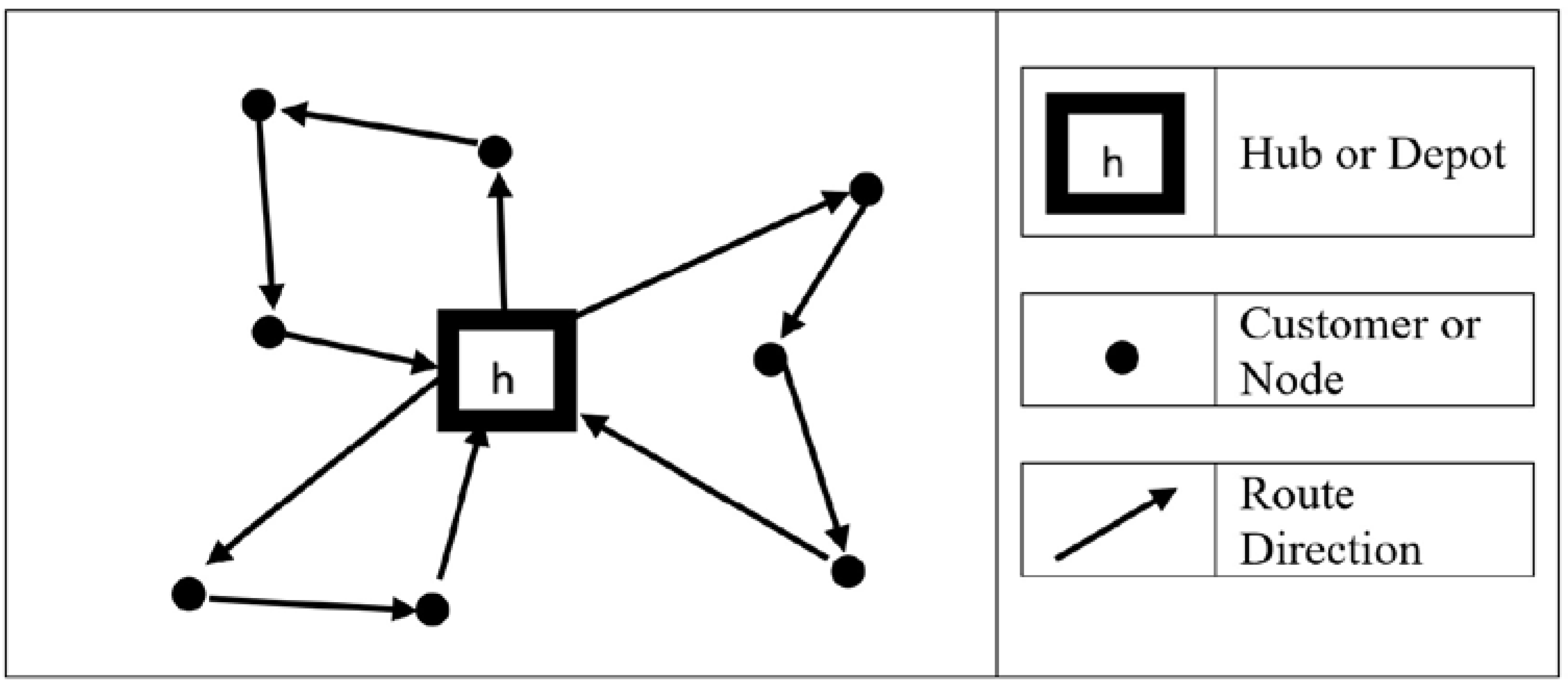
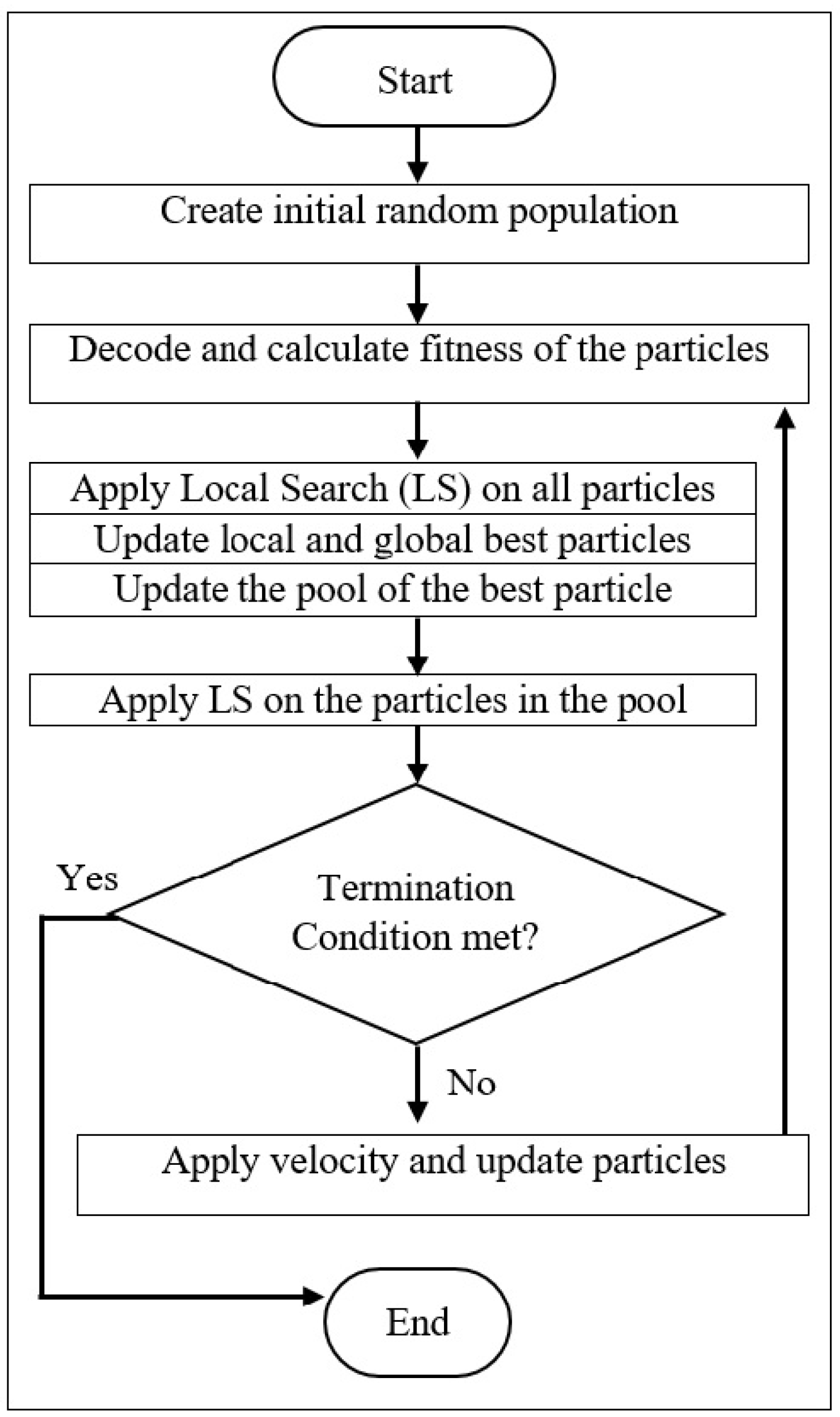

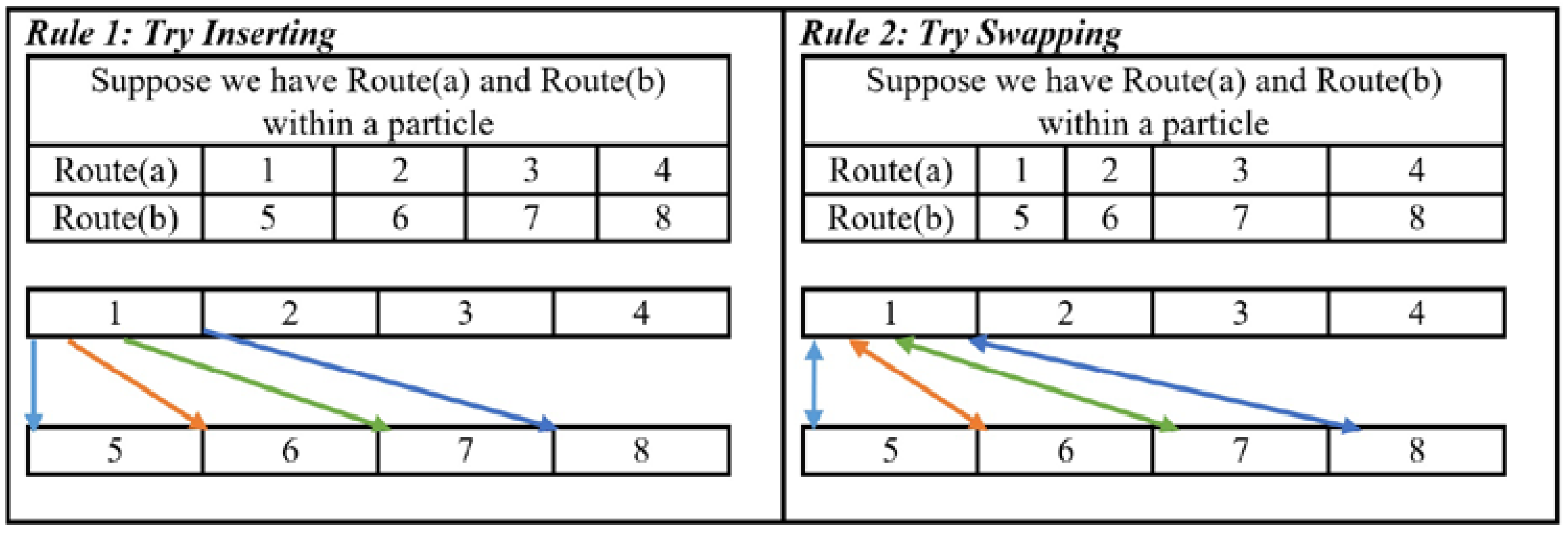
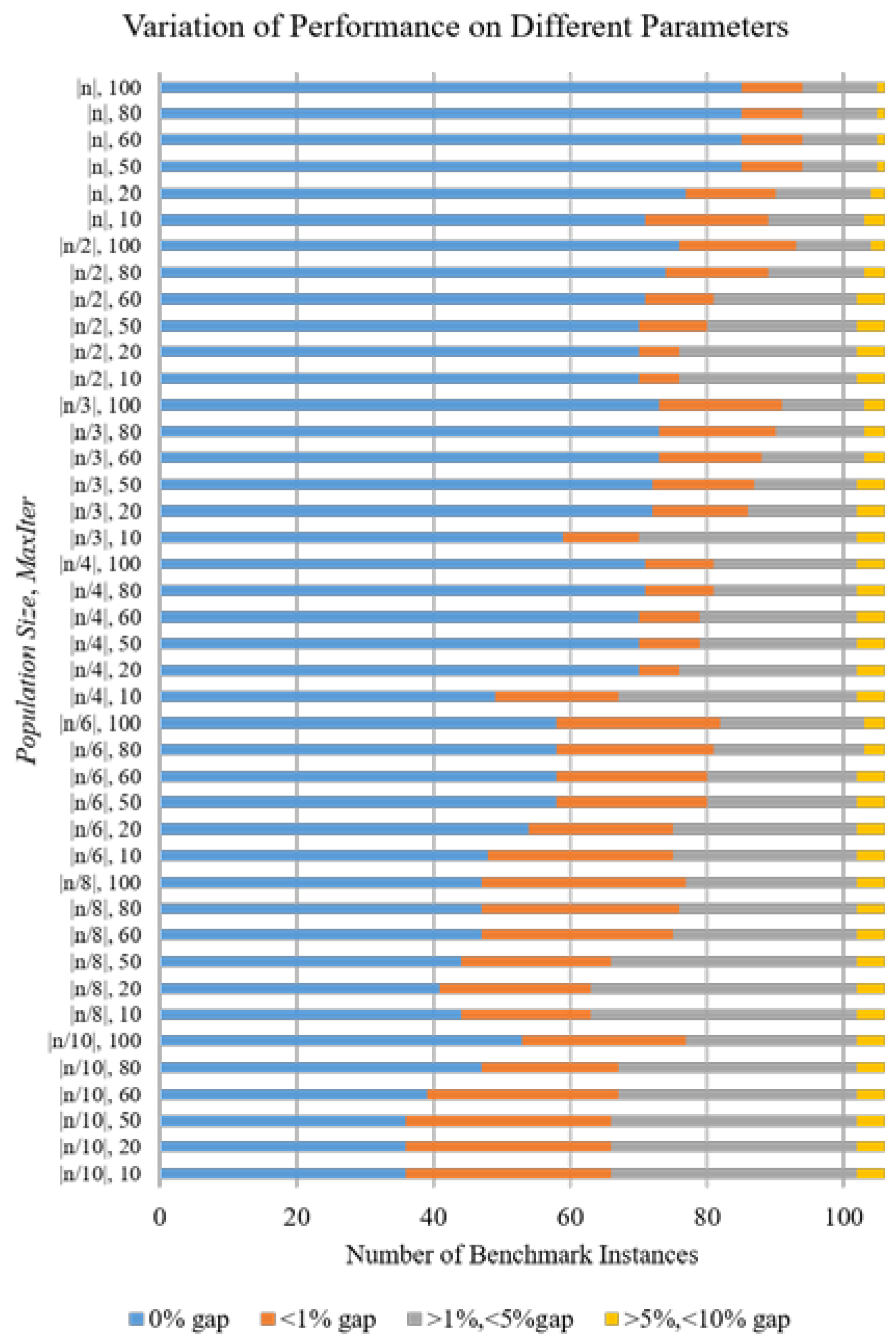
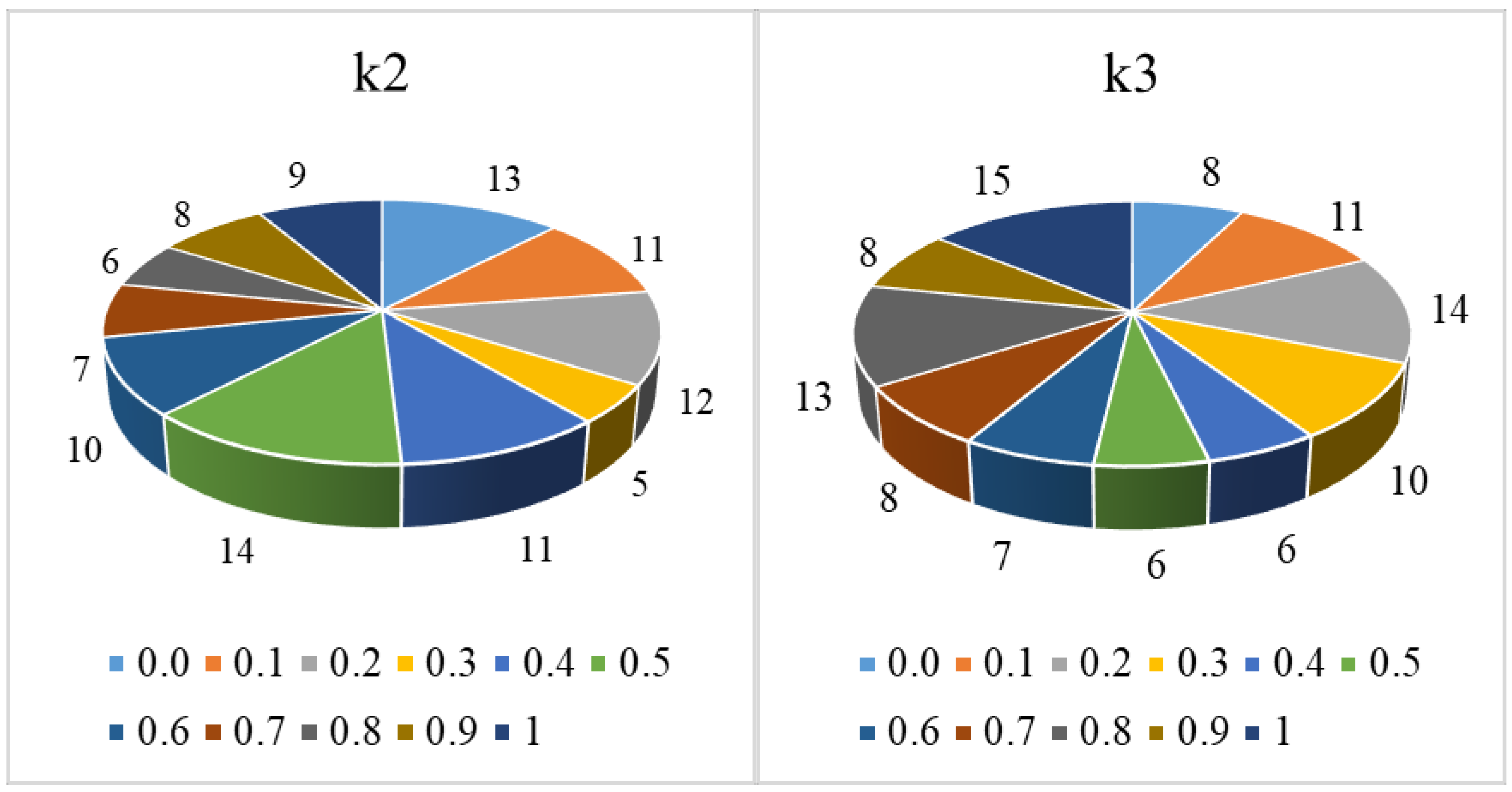
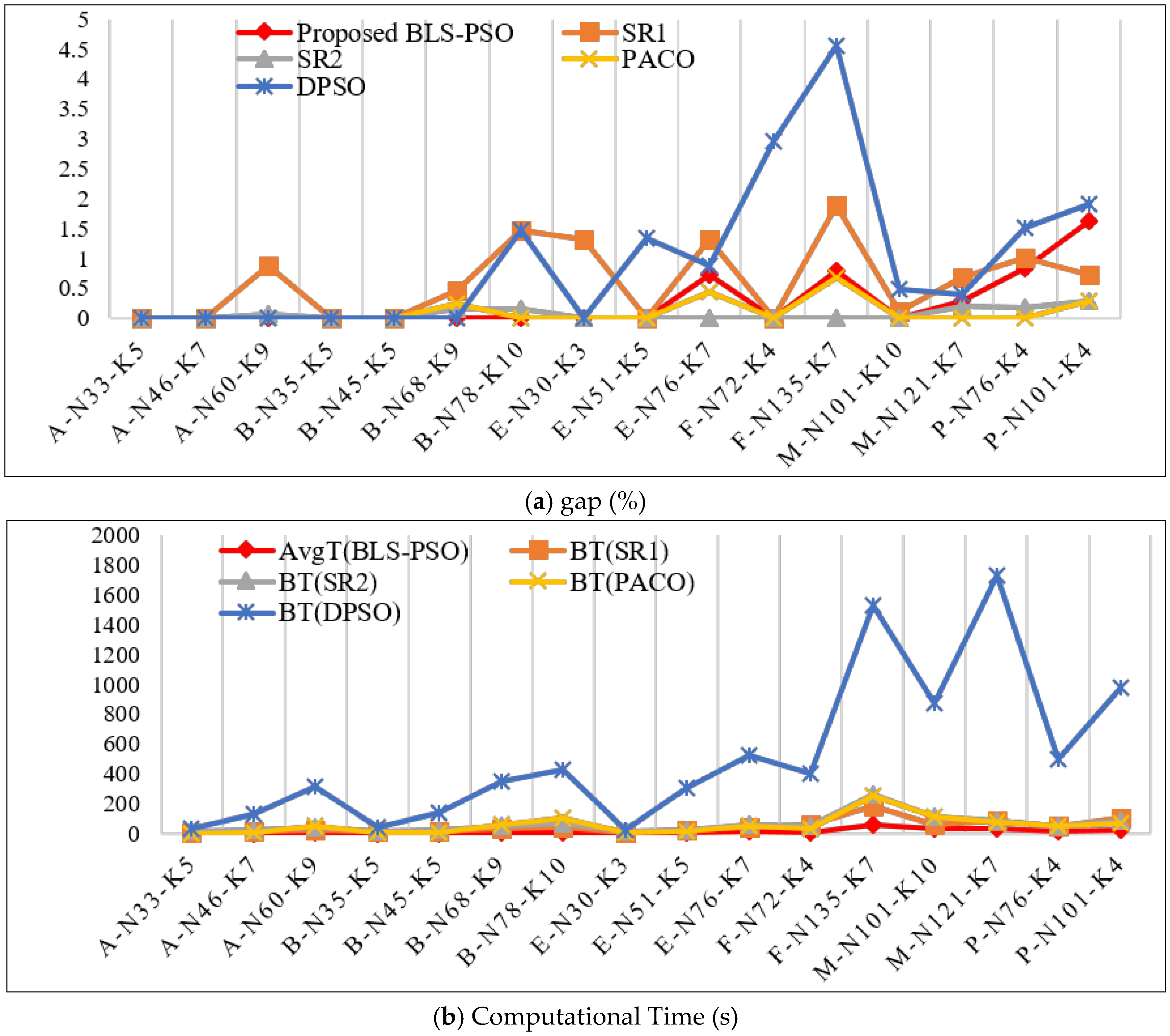

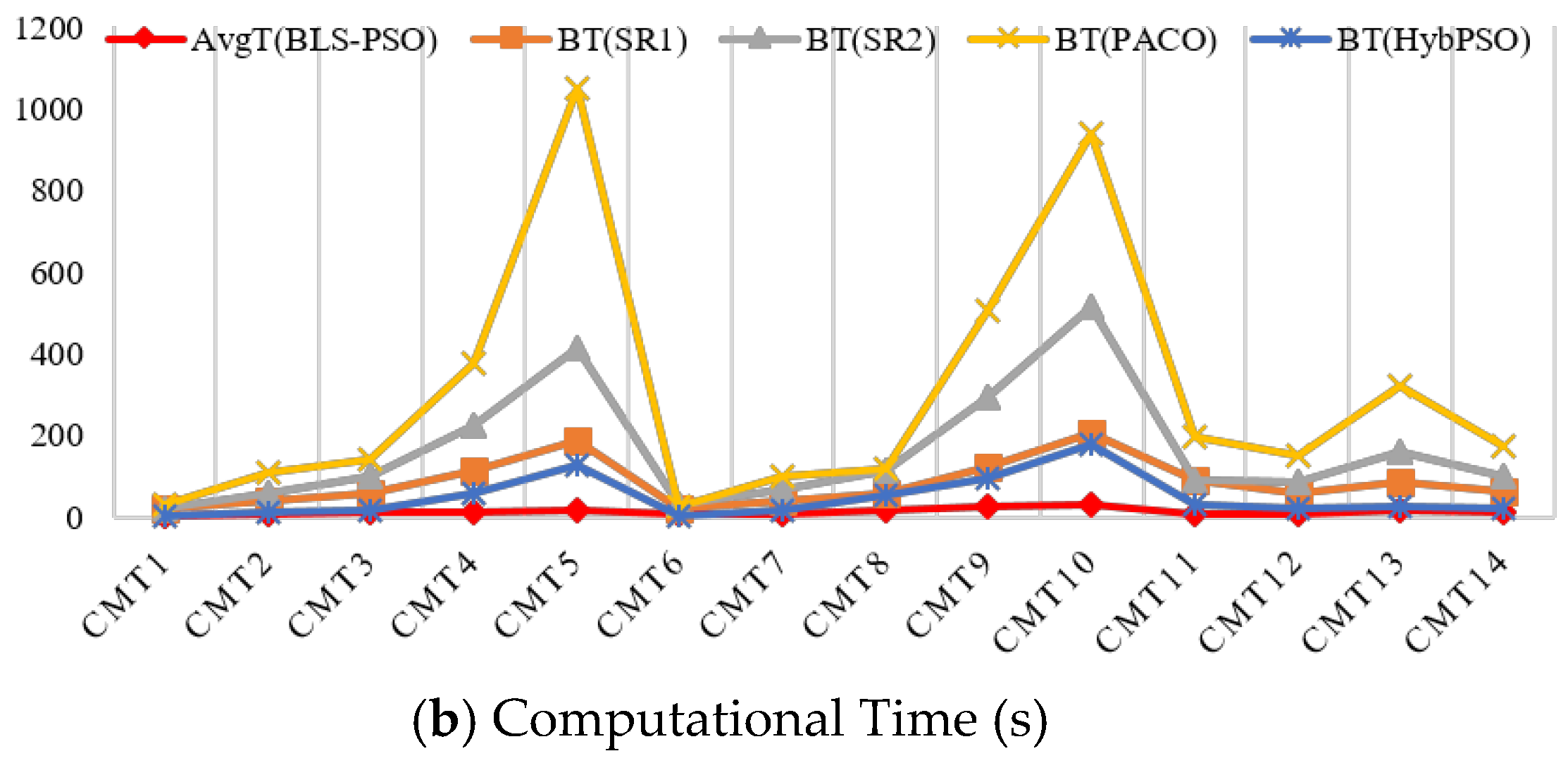
| N | Total number of nodes |
| m | Total number of required vehicles |
| Cost to visit node ck from node cj | |
| Service time required when a vehicle visits node i (for the depot, ) | |
| Q | Maximum capacity of a vehicle |
| TT | Maximum distance of a vehicle can travel to |
| di | Demand of a customer to be served by a vehicle |
| Z | Customer set served by a vehicle; |Z| is the number of customers served by a vehicle |
| Binary decision variable set to 1 if vehicle v serves node k after serving node j, or 0 otherwise |
| Hub ID | Customer IDs | ||||||||||
|---|---|---|---|---|---|---|---|---|---|---|---|
| IDs | 1 | 2 | 3 | 4 | 5 | 6 | 7 | 8 | 9 | 10 | 11 |
| Demands | 0 | 17 | 8 | 16 | 28 | 13 | 8 | 23 | 7 | 6 | 15 |
| PSParticle | T | k2 | k3 |
|---|---|---|---|
| {|n/10|, |n/8|, |n/6|, |n/4|, |n/3|, |n/2|, |n|} | {10, 20, 50, 60, 80, 100} | {between 0 and 1 (with 0.1 interval)} | {between 0 and 1 (with 0.1 interval)} |
| Problems | BKS | CostBLS-PSO | gap | AvgT | k2 | k3 |
|---|---|---|---|---|---|---|
| A-n32-k5 | 784 | 784 | 0.00 | 0.15 | 0.1 | 0.1 |
| A-n33-k5 | 661 | 661 | 0.00 | 0.15 | 0.4 | 0.5 |
| A-n33-k6 | 742 | 742 | 0.00 | 0.43 | 0.4 | 0.0 |
| A-n34-k5 | 778 | 778 | 0.00 | 0.8 | 0.5 | 0.8 |
| A-n36-k5 | 799 | 799 | 0.00 | 0.76 | 0.0 | 0.8 |
| A-n37-k5 | 669 | 669 | 0.00 | 0.92 | 0.8 | 1.0 |
| A-n37-k6 | 949 | 949 | 0.00 | 0.64 | 0.5 | 0.2 |
| A-n38-k5 | 730 | 730 | 0.00 | 0.69 | 1.0 | 0.8 |
| A-n39-k5 | 822 | 822 | 0.00 | 1.07 | 0.5 | 0.3 |
| A-n39-k6 | 831 | 831 | 0.00 | 1.15 | 0.4 | 0.7 |
| A-n44-k6 | 937 | 937 | 0.00 | 1.03 | 0.3 | 0.0 |
| A-n45-k6 | 944 | 944 | 0.00 | 1.76 | 0.0 | 0.2 |
| A-n45-k7 | 1146 | 1146 | 0.00 | 1.31 | 0.5 | 0.0 |
| A-n46-k7 | 914 | 914 | 0.00 | 1.29 | 0.6 | 0.3 |
| A-n48-k7 | 1073 | 1073 | 0.00 | 1.45 | 0.9 | 0.1 |
| A-n53-k7 | 1010 | 1010 | 0.00 | 2.54 | 0.9 | 1.0 |
| A-n54-k7 | 1167 | 1167 | 0.00 | 7.61 | 0.2 | 0.5 |
| A-n55-k9 | 1073 | 1073 | 0.00 | 8.47 | 0.5 | 0.4 |
| A-n60-k9 | 1354 | 1354 | 0.00 | 8.78 | 0.6 | 0.2 |
| A-n61-k9 | 1034 | 1034 | 0.00 | 7.98 | 0.7 | 1.0 |
| A-n62-k8 | 1288 | 1296 | 0.62 | 9.53 | 0.7 | 0.4 |
| A-n63-k9 | 1616 | 1616 | 0.00 | 9.22 | 0.9 | 0.3 |
| A-n63-k10 | 1314 | 1314 | 0.00 | 10.14 | 0.8 | 1.0 |
| A-n64-k9 | 1401 | 1415 | 1.00 | 18.86 | 0.5 | 0.6 |
| A-n65-k9 | 1174 | 1174 | 0.00 | 16.5 | 0.2 | 0.8 |
| A-n69-k9 | 1159 | 1159 | 0.00 | 18.41 | 0.6 | 0.6 |
| A-n80-k10 | 1763 | 1766 | 0.17 | 16.75 | 0.2 | 1.0 |
| Average | 0.07 | 5.5 | -- | -- | ||
| Problems | BKS | CostBLS-PSO | gap | AvgT | k2 | k3 |
|---|---|---|---|---|---|---|
| B-n31-k5 | 672 | 672 | 0.00 | 2.07 | 0.5 | 0.5 |
| B-n34-k5 | 788 | 788 | 0.00 | 2.42 | 0.1 | 0.9 |
| B-n35-k5 | 955 | 955 | 0.00 | 1.12 | 0.6 | 0.8 |
| B-n38-k6 | 805 | 805 | 0.00 | 3.01 | 0.8 | 0.9 |
| B-n39-k5 | 549 | 549 | 0.00 | 3.59 | 0.0 | 0.3 |
| B-n41-k6 | 829 | 829 | 0.00 | 3.93 | 0.2 | 0.3 |
| B-n43-k6 | 742 | 742 | 0.00 | 2.55 | 0.7 | 0.1 |
| B-n44-k7 | 909 | 909 | 0.00 | 3.16 | 0.0 | 0.3 |
| B-n45-k5 | 751 | 751 | 0.00 | 2.04 | 0.8 | 0.2 |
| B-n45-k6 | 672 | 672 | 0.00 | 4.95 | 0.5 | 0.5 |
| B-n50-k7 | 741 | 741 | 0.00 | 5.45 | 0.3 | 0.2 |
| B-n50-k8 | 1312 | 1312 | 0.00 | 5.53 | 0.0 | 0.0 |
| B-n51-k7 | 1032 | 1032 | 0.00 | 5.39 | 0.2 | 0.0 |
| B-n52-k7 | 747 | 747 | 0.00 | 6.18 | 0.1 | 0.6 |
| B-n56-k7 | 707 | 707 | 0.00 | 7.31 | 0.2 | 0.2 |
| B-n57-k7 | 1153 | 1153 | 0.00 | 8.12 | 0.0 | 0.8 |
| B-n57-k9 | 1598 | 1598 | 0.00 | 8.56 | 0.4 | 1.0 |
| B-n63-k10 | 1496 | 1496 | 0.00 | 9.13 | 0.0 | 0.6 |
| B-n64-k9 | 861 | 884 | 2.67 | 16.75 | 1.0 | 0.8 |
| B-n66-k9 | 1316 | 1322 | 0.46 | 15.52 | 1.0 | 0.9 |
| B-n67-k10 | 1032 | 1032 | 0.00 | 8.24 | 0.1 | 1.0 |
| B-n68-k9 | 1272 | 1272 | 0.00 | 6.19 | 0.0 | 0.5 |
| B-n78-k10 | 1221 | 1221 | 0.00 | 9.71 | 0.5 | 0.2 |
| Average | 0.14 | 6.13 | -- | -- | ||
| Problems | BKS | CostBLS-PSO | gap | AvgT | k2 | k3 |
|---|---|---|---|---|---|---|
| E-n22-k4 | 375 | 375 | 0.00 | 0.21 | 0.3 | 0.1 |
| E-n23-k3 | 569 | 569 | 0.00 | 0.2 | 0.1 | 0.6 |
| E-n30-k3 | 534 | 534 | 0.00 | 0.3 | 0.2 | 0.2 |
| E-n33-k4 | 835 | 835 | 0.00 | 1.77 | 0.4 | 0.3 |
| E-n51-k5 | 521 | 521 | 0.00 | 2.81 | 0.1 | 0.8 |
| E-n76-k7 | 682 | 687 | 0.73 | 13.55 | 0.2 | 0.9 |
| E-n76-k8 | 735 | 735 | 0.00 | 27.36 | 0.2 | 0.8 |
| E-n76-k10 | 830 | 830 | 0.00 | 18.62 | 0.4 | 0.6 |
| E-n76-k14 | 1021 | 1021 | 0.00 | 14.69 | 0.2 | 0.3 |
| E-n101-k8 | 815 | 815 | 0.00 | 21.27 | 0.9 | 0.9 |
| E-n101-k14 | 1067 | 1095 | 2.62 | 25.81 | 0.2 | 0.2 |
| Average | 0.31 | 11.51 | -- | -- | ||
| Problems | BKS | CostBLS-PSO | gap | AvgT | k2 | k3 |
|---|---|---|---|---|---|---|
| F-n45-k4 | 724 | 724 | 0.00 | 9.2 | 0.7 | 0.7 |
| F-n72-k4 | 237 | 237 | 0.00 | 7.26 | 0.9 | 0.2 |
| F-n135-k7 | 1162 | 1171 | 0.78 | 60.32 | 0.4 | 0.7 |
| Average | 0.26 | 25.59 | -- | -- | ||
| Problems | BKS | CostBLS-PSO | gap | AvgT | k2 | k3 |
|---|---|---|---|---|---|---|
| M-n101-k10 | 820 | 820 | 0.00 | 28.81 | 0.7 | 1.0 |
| M-n121-k7 | 1034 | 1034 | 0.00 | 33.33 | 0.6 | 0.0 |
| M-n151-k12 | 1015 | 1065 | 4.93 | 83.81 | 0.7 | 0.4 |
| M-n200-k16 | 1274 | 1335 | 4.79 | 90.35 | 0.5 | 1.0 |
| M-n200-k17 | 1275 | 1371 | 7.53 | 107.14 | 0.5 | 1.0 |
| Average | 3.45 | 68.69 | -- | -- | ||
| Problems | BKS | CostBLS-PSO | gap | AvgT | k2 | k3 |
|---|---|---|---|---|---|---|
| P-n16-k8 | 450 | 450 | 0.00 | 0.11 | 0.1 | 0.9 |
| P-n19-k2 | 212 | 212 | 0.00 | 0.1 | 0.9 | 0.0 |
| P-n20-k2 | 216 | 216 | 0.00 | 0.35 | 0.1 | 0.1 |
| P-n21-k2 | 211 | 211 | 0.00 | 0.32 | 0.1 | 0.1 |
| P-n22-k2 | 216 | 216 | 0.00 | 0.71 | 0.1 | 0.7 |
| P-n22-k8 | 603 | 603 | 0.00 | 0.83 | 0.4 | 0.2 |
| P-n23-k8 | 529 | 529 | 0.00 | 1.02 | 0.5 | 0.8 |
| P-n40-k5 | 458 | 458 | 0.00 | 1.33 | 0.5 | 0.2 |
| P-n45-k5 | 510 | 510 | 0.00 | 1.45 | 1.0 | 0.3 |
| P-n50-k7 | 554 | 554 | 0.00 | 1.48 | 0.7 | 0.9 |
| P-n50-k8 | 631 | 631 | 0.00 | 1.05 | 1.0 | 0.1 |
| P-n50-k10 | 696 | 696 | 0.00 | 2.23 | 0.3 | 0.5 |
| P-n51-k10 | 741 | 741 | 0.00 | 3.38 | 0.3 | 0.6 |
| P-n55-k7 | 568 | 568 | 0.00 | 4.32 | 1.0 | 0.1 |
| P-n55-k10 | 694 | 694 | 0.00 | 4.94 | 0.6 | 1.0 |
| P-n55-k15 | 989 | 989 | 0.00 | 4.29 | 1.0 | 0.3 |
| P-n60-k10 | 744 | 744 | 0.00 | 5.83 | 0.8 | 0.1 |
| P-n60-k15 | 968 | 968 | 0.00 | 5.37 | 0.0 | 0.7 |
| P-n65-k10 | 792 | 792 | 0.00 | 6.44 | 0.0 | 0.8 |
| P-n70-k10 | 827 | 833 | 0.73 | 9.24 | 0.8 | 1.0 |
| P-n76-k4 | 593 | 598 | 0.84 | 16.11 | 0.4 | 1.0 |
| P-n76-k5 | 627 | 636 | 1.44 | 15.85 | 0.6 | 0.4 |
| P-n101-k4 | 681 | 692 | 1.62 | 20.17 | 0.5 | 0.7 |
| Average | 0.2 | 4.72 | -- | -- | ||
| Problems | BKS | CostBLS-PSO | gap | AvgT | k2 | k3 |
|---|---|---|---|---|---|---|
| CMT1 | 524.61 | 524.61 | 0.00 | 2.19 | 0.6 | 0.2 |
| CMT2 | 835.26 | 835.26 | 0.00 | 8.44 | 0.4 | 0.8 |
| CMT3 | 826.14 | 826.14 | 0.00 | 10.58 | 0.6 | 1.0 |
| CMT4 | 1028.42 | 1042.8 | 1.4 | 11.82 | 0.9 | 0.0 |
| CMT5 | 1291.29 | 1324.01 | 2.53 | 16.37 | 0.9 | 0.2 |
| CMT6 | 555.43 | 555.43 | 0.00 | 9.11 | 0.4 | 0.4 |
| CMT7 | 909.68 | 909.68 | 0.00 | 7.23 | 0.0 | 0.9 |
| CMT8 | 865.95 | 870.03 | 0.47 | 19.41 | 1.0 | 0.1 |
| CMT9 | 1162.55 | 1177.14 | 1.25 | 25.21 | 0.0 | 1.0 |
| CMT10 | 1395.85 | 1436.84 | 2.93 | 31.04 | 0.6 | 0.7 |
| CMT11 | 1042.12 | 1042.12 | 0.00 | 8.58 | 1.0 | 0.8 |
| CMT12 | 819.56 | 819.56 | 0.00 | 10.08 | 0.1 | 0.1 |
| CMT13 | 1541.14 | 1546.36 | 0.34 | 15.54 | 0.2 | 0.7 |
| CMT14 | 866.37 | 866.37 | 0.00 | 11.07 | 0.0 | 0.4 |
| Average | 0.64 | 13.33 | -- | -- | ||
| SR1 | SR2 | PACO | DPSO | BLS-PSO | |||
|---|---|---|---|---|---|---|---|
| Problem | BKS | Cost | Cost | Cost | Cost | Cost | AvgCost |
| BT | BT | BT | BT | AvgT | |||
| (gap) | (gap) | (gap) | (gap) | (gap) | (SD) | ||
| A-n33-k5 | 661 | 661 | 661 | 661 | 661 | 661 | 661 |
| 11 | 13 | 0.87 | 32.3 | 0.15 | |||
| (0.00) | (0.00) | (0.00) | (0.00) | (0.00) | (0.00) | ||
| A-n46-k7 | 914 | 914 | 914 | 914 | 914 | 914 | 914 |
| 18 | 23 | 6.02 | 128.9 | 1.29 | |||
| (0.00) | (0.00) | (0.00) | (0.00) | (0.00) | (0.00) | ||
| A-n60-k9 | 1354 | 1366 a | 1355 a | 1354 | 1354 | 1354 | 1362 |
| 28 | 40 | 52.88 | 308.8 | 8.78 | |||
| (0.89) | (0.07) | (0.00) | (0.00) | (0.00) | (0.59) | ||
| B-n35-k5 | 955 | 955 | 955 | 955 | 955 | 955 | 955 |
| 12 | 14 | 2.65 | 37.6 | 1.12 | |||
| (0.00) | (0.00) | (0.00) | (0.00) | (0.00) | (0.00) | ||
| B-n45-k5 | 751 | 751 | 751 | 751 | 751 | 751 | 757 |
| 17 | 20 | 5.85 | 134.2 | 2.04 | |||
| (0.00) | (0.00) | (0.00) | (0.00) | (0.00) | (0.8) | ||
| B-n68-k9 | 1272 | 1278 a | 1274 a | 1275 a | 1272 | 1272 | 1289 |
| 33 | 50 | 62.97 | 344.3 | 6.19 | |||
| (0.47) | (0.16) | (0.24) | (0.00) | (0.00) | (1.34) | ||
| B-n78-k10 | 1221 | 1239 a | 1223 a | 1221 | 1239 a | 1221 | 1243 |
| 41 | 64 | 98.78 | 429.4 | 9.71 | |||
| (1.47) | (0.16) | (0.00) | (1.47) | (0.00) | (1.8) | ||
| E-n30-k3 | 534 | 541 a | 534 | 534 | 534 | 534 | 534 |
| 11 | 16 | 4.38 | 28.4 | 0.3 | |||
| (1.31) | (0.00) | (0.00) | (0.00) | (0.00) | (0.00) | ||
| E-n51-k5 | 521 | 521 | 521 | 521 | 528 a | 521 | 531 |
| 21 | 22 | 19.46 | 300.5 | 2.81 | |||
| (0.00) | (0.00) | (0.00) | (1.34) | (0.00) | (1.92) | ||
| E-n76-k7 | 682 | 691 a | 682 | 685 | 688 a | 687 | 696 |
| 38 | 60 | 46.85 | 526.5 | 13.55 | |||
| (1.32) | (0.00) | (0.44) | (0.88) | (0.73) | (2.05) | ||
| F-n72-k4 | 237 | 237 | 237 | 237 | 244 a | 237 | 248 |
| 58 | 53 | 30.64 | 398.3 | 7.26 | |||
| (0.00) | (0.00) | (0.00) | (2.95) | (0.00) | (4.64) | ||
| F-n135-k7 | 1162 | 1184 a | 1162 | 1170 | 1215 a | 1171 | 1192 |
| 178 | 258 | 248.77 | 1526.3 | 60.32 | |||
| (1.89) | (0.00) | (0.69) | (4.56) | (0.78) | (2.58) | ||
| M-n101-k10 | 820 | 821 a | 820 | 820 | 824 a | 820 | 827 |
| 60 | 114 | 113.28 | 874.2 | 28.81 | |||
| (0.12) | (0.00) | (0.00) | (0.49) | (0.00) | (0.85) | ||
| M-n121-k7 | 1034 | 1041 a | 1036 a | 1034 | 1038 a | 1034 | 1040 |
| 88 | 89 | 80.62 | 1733.5 | 33.33 | |||
| (0.68) | (0.19) | (0.00) | (0.39) | (0.00) | (0.58) | ||
| P-n76-k4 | 593 | 599 a | 594 | 593 | 602 a | 598 | 617 |
| 51 | 48 | 53.48 | 496.3 | 16.11 | |||
| (1.01) | (0.17) | (0.00) | (1.52) | (0.84) | (4.05) | ||
| P-n101-k4 | 681 | 686 | 683 | 683 | 694 a | 692 | 699 |
| 99 | 86 | 64.92 | 977.5 | 20.17 | |||
| (0.73) | (0.29) | (0.29) | (1.91) | (1.62) | (2.64) | ||
| Average | -- | -- | -- | -- | -- | -- | |
| 47.81 | 60.63 | 55.78 | 517.3125 | 13.25 | |||
| (0.62) | (0.066) | (0.1) | (0.97) | (0.25) | (1.49) | ||
| SR1 | SR2 | PACO | HybPSO | BLS-PSO | |||
|---|---|---|---|---|---|---|---|
| Problem | BKS | Cost | Cost | Cost | Cost | Cost | AvgCost |
| BT | BT | BT | BT | AvgT | |||
| (gap) | (gap) | (gap) | (gap) | (gap) | (SD) | ||
| CMT1 | 524.61 | 524.61 | 524.61 | 524.61 | 524.61 | 524.61 | 524.61 |
| 21 | 24 | 32.3 | 3 | 2.19 | |||
| (0.00) | (0.00) | (0.00) | (0.00) | (0.00) | (0.00) | ||
| CMT2 | 835.26 | 849.58 a | 844.42 a | 835.26 | 835.26 | 835.26 | 840.39 |
| 39 | 57 | 108 | 13 | 8.44 | |||
| (1.71) | (1.1) | (0.00) | (0.00) | (0.00) | (0.61) | ||
| CMT3 | 826.14 | 835.8 a | 829.4 a | 829.92 a | 826.14 | 826.14 | 836.44 |
| 61 | 101 | 142 | 19 | 10.58 | |||
| (1.17) | (0.39) | (0.46) | (0.00) | (0.00) | (1.25) | ||
| CMT4 | 1028.42 | 1067.57 a | 1048.89 a | 1040.23 | 1029.54 | 1042.8 | 1059.13 |
| 113 | 223 | 378 | 61 | 11.82 | |||
| (3.81) | (1.99) | (1.15) | (0.11) | (1.4) | (2.99) | ||
| CMT5 | 1291.29 | 1345.84 a | 1323.89 | 1348.73 a | 1294.13 | 1324.01 | 1348.27 |
| 188 | 413 | 1049 | 129 | 16.37 | |||
| (4.21) | (2.51) | (4.44) | (0.22) | (2.53) | (4.41) | ||
| CMT6 | 555.43 | 556.68 a | 555.43 | 555.43 | 555.43 | 555.43 | 555.43 |
| 21 | 30 | 28 | 3 | 9.11 | |||
| (0.23) | (0.00) | (0.00) | (0.00) | (0.00) | (0.00) | ||
| CMT7 | 909.68 | 952.77 a | 917.68 a | 909.68 | 909.68 | 909.68 | 917.94 |
| 42 | 69 | 99 | 17 | 7.23 | |||
| (4.74) | (0.88) | (0.00) | (0.00) | (0.00) | (0.91) | ||
| CMT8 | 865.95 | 877.84 a | 867.01 | 868.61 | 868.45 | 870.03 | 884.2 |
| 61 | 115 | 118 | 53 | 19.41 | |||
| (1.37) | (0.12) | (0.31) | (0.29) | (0.47) | (2.11) | ||
| CMT9 | 1162.55 | Inf a | 1181.14 a | 1171.94 | 1164.35 | 1177.14 | 1190.07 |
| 125 | 295 | 506 | 94 | 25.21 | |||
| (Inf) | (1.6) | (0.81) | (0.16) | (1.25) | (2.37) | ||
| CMT10 | 1395.85 | 1465.66 a | 1428.46 | 1454.81 a | 1396.18 | 1436.84 | 1452.23 |
| 208 | 517 | 939 | 181 | 31.04 | |||
| (5.00) | (2.34) | (4.22) | (0.024) | (2.93) | (4.04) | ||
| CMT11 | 1042.12 | 1051.87 a | 1052.34 a | 1042.12 | 1044.03 a | 1042.12 | 1056.88 |
| 89 | 93 | 197 | 32 | 8.58 | |||
| (0.94) | (0.98) | (0.00) | (0.18) | (0.00) | (1.42) | ||
| CMT12 | 819.56 | 820.62 a | 819.56 | 819.56 | 819.56 | 819.56 | 819.56 |
| 60 | 88 | 149 | 23 | 10.08 | |||
| (0.13) | (0.00) | (0.00) | (0.00) | (0.00) | (0.00) | ||
| CMT13 | 1541.14 | 1566.32 a | 1546.2 | 1562.64 a | 1544.18 | 1546.36 | 1558.35 |
| 86 | 160 | 321 | 25 | 15.54 | |||
| (1.63) | (0.33) | (1.4) | (0.197) | (0.34) | (1.12) | ||
| CMT14 | 866.37 | 867.13 a | 866.37 | 866.37 | 866.37 | 866.37 | 866.37 |
| 64 | 99 | 173 | 22 | 11.07 | |||
| (0.09) | (0.00) | (0.00) | (0.00) | (0.00) | (0.00) | ||
| Average | -- | -- | -- | -- | -- | -- | |
| 84.1 | 163.1 | 302.58 | 48.13 | 13.33 | |||
| (1.788) | (0.874) | (0.913) | (0.084) | (0.64) | (1.52) | ||
© 2018 by the authors. Licensee MDPI, Basel, Switzerland. This article is an open access article distributed under the terms and conditions of the Creative Commons Attribution (CC BY) license (http://creativecommons.org/licenses/by/4.0/).
Share and Cite
Ahmed, A.K.M.F.; Sun, J.U. Bilayer Local Search Enhanced Particle Swarm Optimization for the Capacitated Vehicle Routing Problem. Algorithms 2018, 11, 31. https://doi.org/10.3390/a11030031
Ahmed AKMF, Sun JU. Bilayer Local Search Enhanced Particle Swarm Optimization for the Capacitated Vehicle Routing Problem. Algorithms. 2018; 11(3):31. https://doi.org/10.3390/a11030031
Chicago/Turabian StyleAhmed, A. K. M. Foysal, and Ji Ung Sun. 2018. "Bilayer Local Search Enhanced Particle Swarm Optimization for the Capacitated Vehicle Routing Problem" Algorithms 11, no. 3: 31. https://doi.org/10.3390/a11030031





